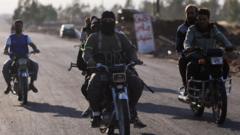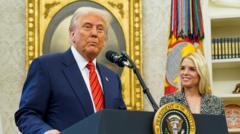Findings reveal U.S. airstrikes only temporarily hindered Iran's nuclear ambitions as a fragile ceasefire takes center stage in the ongoing conflict between Iran and Israel.**
Insights into U.S. Airstrikes on Iran Amid Continuing Tensions**

Insights into U.S. Airstrikes on Iran Amid Continuing Tensions**
A detailed analysis of the recent U.S. military strikes on Iranian nuclear facilities and the impact of the ongoing ceasefire.**
A classified U.S. report has shed light on the recent airstrikes targeting Iranian nuclear sites, indicating that while operations did result in the sealing of entry points at two facilities, they ultimately only set back Iran's nuclear capabilities by a matter of months. This new information comes as a ceasefire is reportedly stabilizing following a brief yet fierce conflict between Iran and Israel.
According to sources familiar with the report’s findings, the bombing did not result in the collapse of the underground structures at the targeted sites, contradicting previous statements by officials, including President Trump's claim that Iran's nuclear infrastructure had been "obliterated." A spokesperson for the White House refuted this assessment, calling it "flat-out wrong."
Meanwhile, details surrounding the ceasefire remain opaque. The Israeli military has begun to lift previously imposed emergency measures, while Iran's President has declared an end to what he described as a "12-day war that was forced upon the Iranian people" during a recent national address.
The period of conflict saw both countries engaging in hostilities, after which they each issued conflicting narratives regarding accountability for the violence. After initially expressing frustration over the strikes that continued despite his announcement of a truce, President Trump later expressed approval for both nations' efforts to quell the fighting, asserting on social media, "It was my great honor to destroy all nuclear facilities & capability, and then stop the war!"
These developments highlight the complexities of the ongoing tensions within the region and the uncertain path toward diplomatic resolution. As both sides continue to assert their narratives, the international community remains watchful for any shifts in the fragile peace that has been established.





















